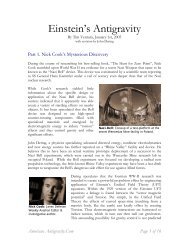A world of connections - Signal Lake Venture Fund
A world of connections - Signal Lake Venture Fund
A world of connections - Signal Lake Venture Fund
Create successful ePaper yourself
Turn your PDF publications into a flip-book with our unique Google optimized e-Paper software.
YouTube video in return. With sensor networks this traffic asymmetry is inverted:<br />
they send far more data than they receive. Although each individual consignment <strong>of</strong><br />
data is tiny, they add up. And some sensors send out a steady heartbeat, if only to<br />
say “I'm still here!”, which sets <strong>of</strong>f a communications session throughout the<br />
network.<br />
What worries engineers most is how to deal with all the data produced by the<br />
sensors. “The good news is that you can get all these data; the bad news is that you<br />
have to do something with them,” says Kris Pister, the co-founder <strong>of</strong> Dust Networks.<br />
Efforts are under way to increase the processing power <strong>of</strong> the sensors so that they<br />
can analyse the information themselves rather than just collecting it and passing it<br />
on.<br />
But this wealth <strong>of</strong> information creates opportunities as well. Teruyasu Murakami <strong>of</strong><br />
Nomura Research Institute believes that having things continuously connected to a<br />
network will open up new markets and new ways <strong>of</strong> living. And Bob Karschnia <strong>of</strong><br />
Emerson Process Management, which designs and builds factory automation systems<br />
such as the one at BP's Cherry Point Refinery, digs through the mountains <strong>of</strong> data to<br />
find new ways for businesses to operate. At times, he philosophises about what the<br />
technology means. The interconnected machines are akin to the brain's neural<br />
pathways, he suggests. “If we are computing and connecting like the brain, we<br />
should be able to emulate memory,” he says. “How do you create ‘memories' in the<br />
processes <strong>of</strong> a factory?”<br />
As machines talk to other machines, they may uncover facts and relationships that<br />
are not apparent to people. That may enable factories to “learn” and find ways to<br />
become more efficient. What happens on the factory floor will make its way, in a<br />
different form, to <strong>of</strong>fice buildings and homes. The next step is for wireless technology<br />
to enter human beings themselves.<br />
Copyright © 2007 The Economist Newspaper and The Economist Group. All rights reserved.





